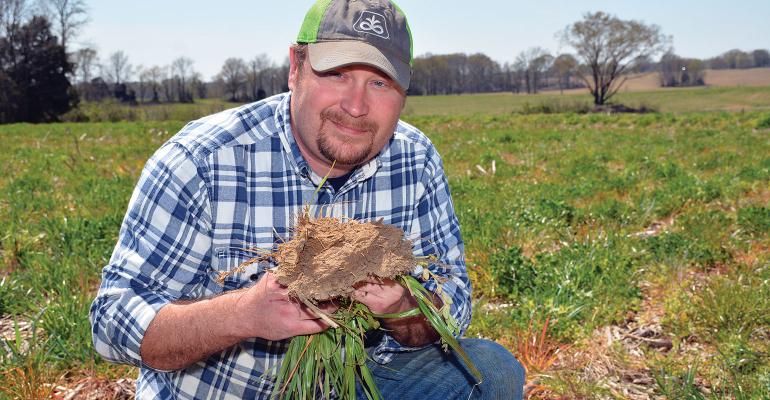Cover crops have made a significant difference for Matt Griggs’ Humboldt, Tenn., farm.
“It’s been impressive,” says Matt, 38, who farms with his wife Kelley, 41, on a cotton, corn, soybean and wheat farm that goes back five generations. “I can trace it back to 1882,” Matt says, to when his great, great grandfather bought a cotton gin in what was once the bustling village of Mason Grove. Both the railroad and the prosperity that would have come with it bypassed Mason Grove, leaving a farming community that endures.
Griggs intends that the farm endures as well and has put in place a philosophy of sustainable production to make that happen.
“We are big on cover crops,” Griggs says, explaining that the lynchpin of his stewardship efforts is improving soil health, increasing water infiltration and boosting yields.
“We plant everything into green cover,” he says, “because we want to let the cover get as big as possible to produce more biomass and add more nitrogen to the soil.” His cover crop mix includes legumes — crimson clover, vetch and winter pea.
“We went to cover crops on a large scale in 2015, so this is the fourth year planting into green.” Except for cotton, he plants through the mature biomass. “We don’t terminate until the day we plant,” he says. “We spray, come back with a roller and then plant.”
Planting cotton
He had issues planting cotton into that thick cover. “Seed-to-soil contact was not what we needed,” he explains. “Last year, we found a way. We sprayed herbicide to kill the cover on a narrow band and planted into that. We got a perfect stand of cotton and we made the best cotton ever, 1,100 pounds per acre.” That’s dryland production.
He says in the last four years he’s “seen some of the best yields ever.”
He does recall, however, that one of the best crops he ever made was in 2014, the year before he converted to no-till cover. “Net profit that year was $50 an acre,” he says. “I was farming out of a jug. The next year, with the first cover crop, yields were less but profit was up, $100 per acre.”
Lower weed control cost made possible with cover crops, made a difference, Griggs says. “I cut my herbicide costs in half.”
Palmer amaranth has been an issue, but keeping cover on the fields year-round reduces weed germination. “We have zero tolerance for pigweed,” he says.
Kelley adds that it’s not unusual for Matt to stop his truck, walk out into a field to pull up one pigweed.
“They can produce up to 1 million seeds,” Griggs says.
Soil health
He’s also using cover crops to build soil health. “Organic matter has improved from 1.5 percent to 3 percent,” he says.
Water infiltration rate changed significantly. “With no-till but no cover crop, the maximum water infiltration rate is about 2 inches per hour. I’ve documented infiltration on cover crop fields at 62 inches an hour.”
He explains that infiltration rate was 62 inches per hour for the first inch of rainfall and 12 inches per hour for the second inch.
“On the no-till, it was 2 inches per hour for the first inch and the second inch would not infiltrate. This was on long-term, 15-year no-till. The cover crop plot beside it was on its third year with a cover.”
For years, Griggs says, agriculture has paid too little attention to soil health. “We have degraded soil. Now, we know we have to build it back up. Soil and sun are the basis for growing plants and soil is the world’s most valuable resource.”
Rotation plays a role in preserving and improving that resource. Griggs says it is more than rare to plant the same crop in a field two years in a row. “We plant equal 25 percent acreage to each crop,” he says. Soybeans may follow wheat in a double-cropping system.
“Not all of our land is good wheat land,” he says.
As the wheat edges toward maturity, they are preparing to plant corn, soybeans and cotton. “I’ll probably plant cotton the first of May,” Griggs says, “depending on the weather.”

Matt and Kelley Griggs check the yellowing bands of vegetation where they will plant cotton next month. The terminated bands, Matt says, improve seed-to-soil contact and improves germination.
Timing important
In early April, they were waiting on conditions to improve enough to plant corn and soybeans. Timing is important. “It’s not always good to be the first in the field with a planter,” Kelley says. “Patience is a good thing. It’s not the calendar but the weather and the soil temperature that matter.”
They say timing is important on the back end, too. “We have one basket cotton picker and one combine,” Griggs says. “We want to get cotton picked in two to three weeks because we have other crops to harvest.”
They say cover crops work well in dryland farming. “We can’t irrigate here,” Griggs says, “so a cover crop is one way to drought-proof the crops. We conserve moisture with green plants.”
A devastating drought in 2007 drove home the importance of moisture management. “We lost $100,000 that year,” he says.
The cover crop experiment began in 2010 with tillage radishes. “Those were baby steps, just learning,” Griggs says. “We have learned that no-till alone is not sustainable.”
Matt and Kelley agree that conversion to full rotation and no-till cover crop agriculture requires a new mindset. “We had to change our thinking on production,” he says.
“If you don’t change the way you do things, you will not survive,” Kelley says.
The Griggs Farm commitment to sustainable production is currently featured on a History Channel documentary, The American Farm. It airs Thursday evenings at 10.


